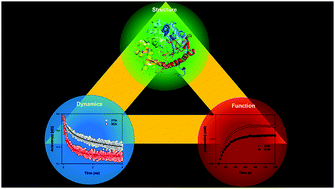当前位置:
X-MOL 学术
›
Soft Matter
›
论文详情
Our official English website, www.x-mol.net, welcomes your
feedback! (Note: you will need to create a separate account there.)
Flexibility modulates the catalytic activity of a thermostable enzyme: key information from optical spectroscopy and molecular dynamics simulation
Soft Matter ( IF 2.9 ) Pub Date : 2020/02/13 , DOI: 10.1039/c9sm02479d Pritam Biswas 1, 2, 3, 4 , Aniruddha Adhikari 4, 5, 6, 7, 8 , Uttam Pal 4, 7, 8, 9 , Priya Singh 4, 5, 6, 7, 8 , Monojit Das 4, 10, 11, 12, 13 , Tanusri Saha-Dasgupta 4, 7, 8, 14 , Sudeshna Shyam Choudhury 1, 2, 3, 4 , Ranjan Das 4, 15, 16, 17 , Samir Kumar Pal 4, 5, 6, 7, 8
Soft Matter ( IF 2.9 ) Pub Date : 2020/02/13 , DOI: 10.1039/c9sm02479d Pritam Biswas 1, 2, 3, 4 , Aniruddha Adhikari 4, 5, 6, 7, 8 , Uttam Pal 4, 7, 8, 9 , Priya Singh 4, 5, 6, 7, 8 , Monojit Das 4, 10, 11, 12, 13 , Tanusri Saha-Dasgupta 4, 7, 8, 14 , Sudeshna Shyam Choudhury 1, 2, 3, 4 , Ranjan Das 4, 15, 16, 17 , Samir Kumar Pal 4, 5, 6, 7, 8
Affiliation

|
Enzymes are dynamical macromolecules and their conformation can be altered via local fluctuations of side chains, large scale loop and even domain motions which are intimately linked to their function. Herein, we have addressed the role of dynamic flexibility in the catalytic activity of a thermostable enzyme almond beta-glucosidase (BGL). Optical spectroscopy and classical molecular dynamics (MD) simulation were employed to study the thermal stability, catalytic activity and dynamical flexibility of the enzyme. An enzyme assay reveals high thermal stability and optimum catalytic activity at 333 K. Polarization-gated fluorescence anisotropy measurements employing 8-anilino-1-napthelenesulfonic acid (ANS) have indicated increasing flexibility of the enzyme with an increase in temperature. A study of the atomic 3D structure of the enzyme shows the presence of four loop regions (LRs) strategically placed over the catalytic barrel as a lid. MD simulations have indicated that the flexibility of BGL increases concurrently with temperature through different fluctuating characteristics of the enzyme's LRs. Principal Component Analysis (PCA) and the Steered Molecular Dynamics (SMD) simulation manifest the gatekeeper role of the four LRs through their dynamic fluctuations surrounding the active site which controls the catalytic activity of BGL.
中文翻译:

灵活性调节了热稳定酶的催化活性:来自光谱学和分子动力学模拟的关键信息
酶是动态大分子和其构象可以改变通过侧链的局部波动,大规模循环,甚至是区域运动都与其功能密切相关。在这里,我们已经解决了动态柔韧性在热稳定酶杏仁β-葡萄糖苷酶(BGL)催化活性中的作用。光谱学和经典分子动力学(MD)模拟被用来研究酶的热稳定性,催化活性和动态柔性。酶测定法显示了在333 K时的高热稳定性和最佳催化活性。使用8-苯胺基-1-萘烯磺酸(ANS)进行极化选通的荧光各向异性测量表明,酶的灵活性随温度的升高而增加。对酶原子3D结构的研究表明,有策略地将四个环区域(LR)放置在催化桶上作为盖子。MD模拟表明,通过酶LRs的不同波动特性,BGL的柔韧性随温度增加。主成分分析(PCA)和分子导向动力学(SMD)模拟通过围绕控制着BGL催化活性的活性位点周围的动态波动来显示四个LR的看门人作用。
更新日期:2020-03-26
中文翻译:

灵活性调节了热稳定酶的催化活性:来自光谱学和分子动力学模拟的关键信息
酶是动态大分子和其构象可以改变通过侧链的局部波动,大规模循环,甚至是区域运动都与其功能密切相关。在这里,我们已经解决了动态柔韧性在热稳定酶杏仁β-葡萄糖苷酶(BGL)催化活性中的作用。光谱学和经典分子动力学(MD)模拟被用来研究酶的热稳定性,催化活性和动态柔性。酶测定法显示了在333 K时的高热稳定性和最佳催化活性。使用8-苯胺基-1-萘烯磺酸(ANS)进行极化选通的荧光各向异性测量表明,酶的灵活性随温度的升高而增加。对酶原子3D结构的研究表明,有策略地将四个环区域(LR)放置在催化桶上作为盖子。MD模拟表明,通过酶LRs的不同波动特性,BGL的柔韧性随温度增加。主成分分析(PCA)和分子导向动力学(SMD)模拟通过围绕控制着BGL催化活性的活性位点周围的动态波动来显示四个LR的看门人作用。











































 京公网安备 11010802027423号
京公网安备 11010802027423号